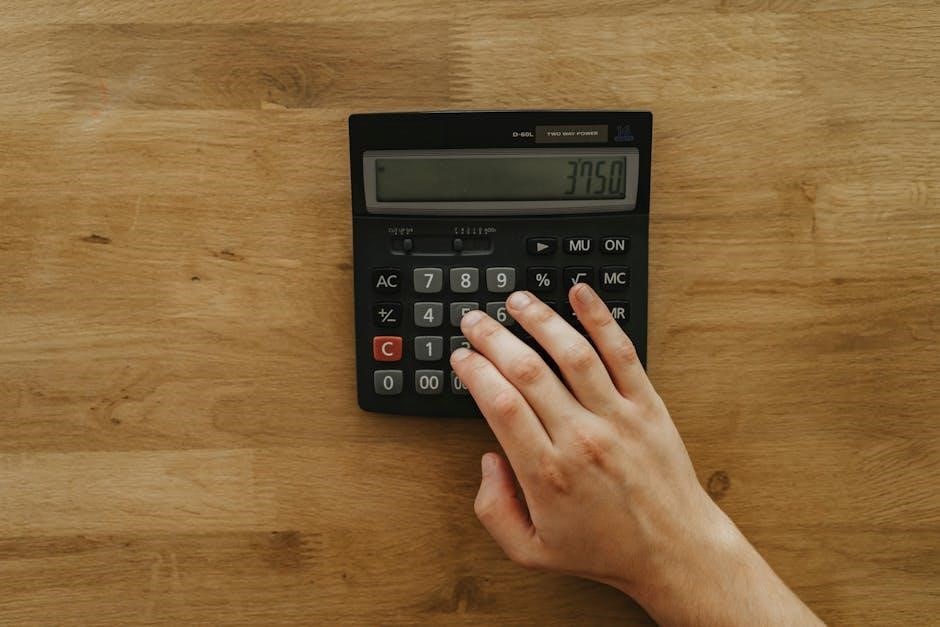Manual calculators are tactile tools enabling basic arithmetic operations, fostering mental math skills and serving as reliable alternatives to electronic devices, promoting precision and hands-on problem-solving.
1;1 Definition and Purpose
A manual calculator is a mechanical or analog device used for performing mathematical calculations without electronic assistance. Its primary purpose is to assist in basic arithmetic operations like addition, subtraction, multiplication, and division. These tools are often used for educational purposes to teach fundamental math concepts and mental arithmetic skills. They also serve professionals in fields requiring precise, reliable calculations. Unlike digital calculators, manual calculators rely on human input and mechanical processes, making them a sustainable and fail-safe option for everyday use.
1.2 Brief History of Manual Calculators
Manual calculators trace their origins to ancient tools like the abacus, used for counting and basic arithmetic. In the 17th century, Blaise Pascal invented the Pascaline, a mechanical calculator for addition and subtraction. Later, Gottfried Wilhelm Leibniz developed the Stepped Reckoner, adding multiplication and division. By the 19th century, Charles Babbage conceptualized the Analytical Engine, a mechanical computer. The 20th century saw portable manual calculators, revolutionizing calculations before digital devices emerged. These devices laid the foundation for modern computational tools.
1.3 Advantages Over Electronic Calculators
Manual calculators offer unique benefits over electronic ones. They promote mental arithmetic skills, encouraging users to understand mathematical processes deeply. Tactile interaction enhances learning and retention, making them ideal educational tools. Unlike electronic calculators, manual devices don’t rely on batteries, ensuring operation during power outages. Their durability and simplicity reduce maintenance needs. Additionally, they foster a sense of accomplishment and connection to the calculations, making them valuable for both educational and professional settings where precision and understanding are paramount.

Components of a Manual Calculator
Manual calculators consist of mechanical parts, dials, levers, and display mechanisms. These components work together to enable precise mathematical operations, offering durability and reliability in calculations.
2.1 Mechanical Parts and Their Functions
Manual calculators rely on intricate mechanical parts, including gears, levers, and springs. These components work in harmony to perform arithmetic operations. Gears transfer rotational motion, levers amplify force, and springs return parts to their original position. Together, they enable precise calculations, ensuring reliability and durability. The mechanical design requires precise alignment to minimize friction and mechanical resistance, allowing users to handle complex computations efficiently. This engineering ensures accuracy and longevity, making manual calculators dependable tools for various mathematical tasks.
2.2 Dials, Levers, and Other Input Mechanisms
Dials and levers are primary input mechanisms in manual calculators, enabling users to set numbers and perform operations. Dials rotate to select digits, while levers execute functions like resetting or clearing. Additional mechanisms, such as sliding bars or buttons, facilitate specific inputs or operations. These components ensure precise control over calculations, allowing users to handle complex arithmetic with accuracy and efficiency. Their design emphasizes tactile feedback, making manual calculators intuitive and reliable for various mathematical tasks.
2.3 Display and Result Mechanisms
Manual calculators use mechanical displays to show results, often through rotating drums or visible dials. Numbers align in windows or on drums to present calculations. Internal gears synchronize with dials to ensure accurate outputs. Results are displayed step-by-step, allowing users to track progress. This mechanical precision ensures reliability and transparency in computations, making manual calculators dependable for precise arithmetic operations and fostering a clear understanding of the calculation process.

Types of Manual Calculators
Manual calculators are versatile tools, ranging from mechanical to analog and specialized versions, each designed for specific tasks and enhancing mathematical problem-solving abilities effectively.
3.1 Mechanical Calculators
Mechanical calculators are intricate devices using gears and levers to perform arithmetic operations. They were widely used before electronic calculators, offering a hands-on approach to calculations. These devices required manual input, often through cranks or dials, and provided immediate feedback. Mechanical calculators were valued for their durability and ability to function without electricity. They also played a significant role in education, helping users understand mathematical processes. Despite their slower operation compared to modern tools, they remain collector’s items and symbols of early computational innovation.
3.2 Analog Calculators
Analog calculators rely on physical components like slides, dials, or continuous scales to perform calculations. They excel in providing quick estimations and approximate values, making them ideal for fields such as engineering and navigation. Popular examples include slide rules, which enable rapid multiplication, division, and logarithmic calculations. Analog calculators are portable, easy to use, and require no electricity, preserving their relevance in specific niches. They also serve as valuable educational tools, teaching mathematical relationships and proportions, despite offering less precision compared to mechanical calculators.
3.3 Specialized Manual Calculators
Specialized manual calculators are designed for specific industries, offering tailored functions for precise tasks. Examples include aviation calculators for navigation and construction calculators for building measurements. These tools often feature built-in formulas and conversion charts, streamlining complex calculations in their respective fields. Their portability and durability make them indispensable in rugged environments. While less common than general-use calculators, they remain essential for professionals requiring specialized computations, blending tradition with niche functionality to meet unique demands efficiently and accurately.
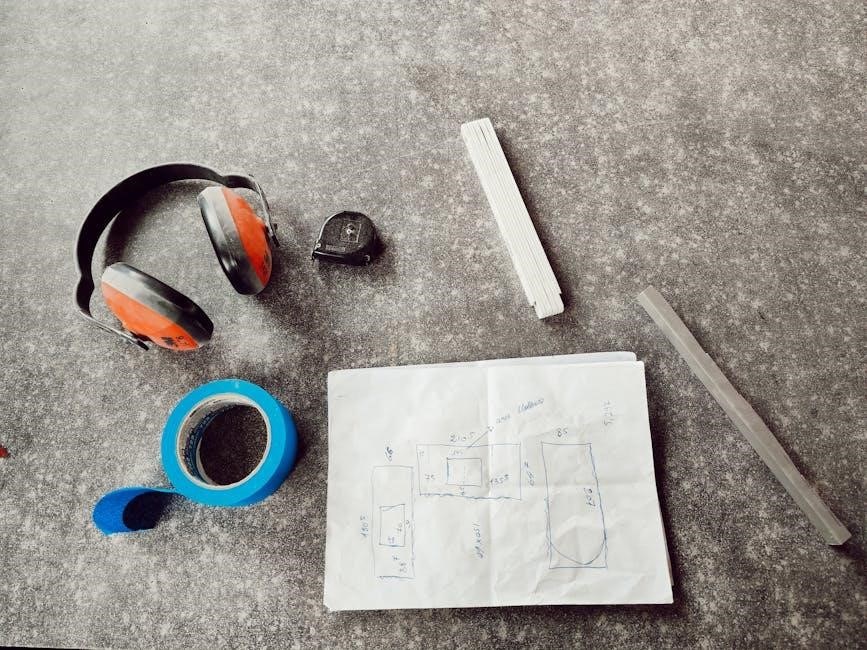
How Manual Calculators Work
Manual calculators operate via mechanical gears, dials, and levers, enabling precise arithmetic operations like addition, subtraction, multiplication, and division through manual input, requiring attention to detail for accuracy.
4.1 Basic Mathematical Operations
Manual calculators excel in performing fundamental arithmetic operations such as addition, subtraction, multiplication, and division. Users input numbers via dials or levers, and the device mechanically computes the results. This hands-on approach ensures precision and control, making manual calculators ideal for educational purposes and professionals requiring accurate, reliable calculations without electronic dependencies. Their mechanical nature fosters a deeper understanding of mathematical processes, enhancing problem-solving skills through tangible interaction with numbers and operations.
4.2 Advanced Calculations and Limitations
Manual calculators can perform advanced operations like squares, square roots, and percentages with precision. However, complex calculations require manual breakdown into simpler steps, limiting efficiency for large datasets or intricate mathematical problems. While they excel in basic operations, tasks like trigonometric functions or exponential calculations are beyond their mechanical capabilities, emphasizing their suitability for foundational arithmetic rather than high-level computations. This highlights both their utility and the boundaries of their functionality compared to electronic alternatives.
4.3 Step-by-Step Operation Guide
Using a manual calculator involves setting dials, turning handles, and interpreting results. Begin by aligning the dials with the desired numbers, ensuring proper alignment for accurate calculations. Perform operations like addition or subtraction by rotating the handle clockwise or counterclockwise. For multiplication and division, break down the problem into simpler steps. Always reset the calculator after each operation to avoid errors. Regular practice enhances efficiency and reduces mistakes, making manual calculators a reliable tool for precise arithmetic.

Applications of Manual Calculators
Manual calculators are used in education, professions, and daily life, aiding precise calculations without electricity, fostering arithmetic skills, and serving as reliable tools in various practical scenarios.
5.1 Educational Use
Manual calculators are invaluable in education, helping students develop fundamental arithmetic skills and mental math abilities. They enhance understanding of mathematical concepts by providing a tangible, hands-on approach to calculations. Teachers often use them to demonstrate step-by-step problem-solving, making complex operations more accessible. Their reliance on human input fosters a deeper connection to numbers and processes, preparing learners for advanced math. Additionally, they serve as excellent tools in classrooms without access to electricity, ensuring uninterrupted learning and practical skill development.
5.2 Professional and Industrial Use
Manual calculators are widely used in professional and industrial settings for their reliability and precision. They are essential in environments where electricity is unavailable or unreliable, ensuring uninterrupted calculations. Professionals like engineers, architects, and financial analysts rely on them for quick, accurate computations. Their portability makes them ideal for fieldwork, while their durability withstands demanding conditions. Additionally, manual calculators serve as backup tools in case of electronic device failures, maintaining productivity and efficiency in critical industries where precise calculations are paramount for decision-making and operations.
5.3 Everyday Practical Uses
Manual calculators are handy for everyday tasks like budgeting, shopping, and simple arithmetic. They are portable and reliable, making them ideal for quick calculations without needing electricity. Useful for teaching children basic math, they also serve as backup tools during power outages or when digital devices are unavailable. Their tactile nature enhances mental math skills, providing a practical, low-tech solution for daily needs, ensuring accuracy and convenience in various personal and household scenarios.
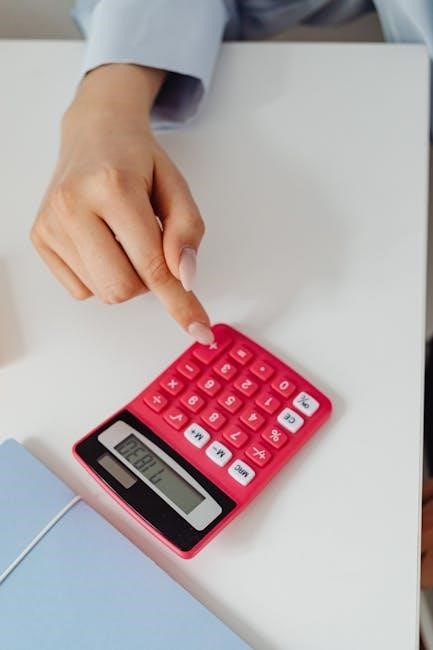
Mental Math and Manual Calculators
Manual calculators enhance mental math by requiring users to understand calculations deeply, fostering arithmetic skills and problem-solving abilities through hands-on, methodical computation practices.
6.1 Developing Mental Arithmetic Skills
Manual calculators actively engage users in mathematical processes, enhancing mental arithmetic by requiring a deep understanding of each operation. This hands-on approach fosters improved focus, problem-solving, and retention of mathematical concepts. By minimizing reliance on automated solutions, users develop stronger cognitive abilities and accuracy in calculations. Regular use of manual calculators encourages a deeper connection to numbers, making mental math more intuitive and efficient over time.
6.2 Using Manual Calculators to Enhance Math Abilities
Manual calculators enhance math abilities by requiring users to understand the underlying calculations, fostering a deeper connection to mathematical concepts. They encourage active engagement, making learning interactive and intuitive. By relying on manual operations, users develop a stronger grasp of number relationships and arithmetic principles. This hands-on approach reduces dependence on electronic devices, improving overall math proficiency and problem-solving skills. Regular use can significantly enhance one’s ability to apply mathematical concepts in real-world scenarios.
6.3 Overcoming Challenges in Manual Calculations
Mastering manual calculations requires patience and practice to overcome common challenges like computation errors and time constraints. Breaking down complex problems into simpler steps can enhance accuracy. Regular practice strengthens mental arithmetic skills, reducing reliance on aids. Cross-verifying results with alternative methods ensures reliability. Embracing a systematic approach and staying attentive minimizes mistakes, fostering confidence and efficiency in manual computations over time.
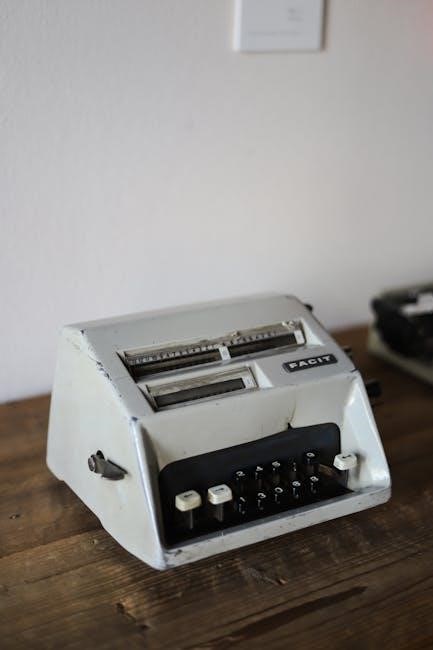
Manual vs. Digital Calculators
Manual calculators offer reliability, durability, and a tactile experience, promoting mental math skills, while digital calculators provide speed, portability, and advanced computation capabilities, catering to different user needs.
7.1 Speed and Accuracy Comparison
Manual calculators require manual input, slowing down calculations but ensuring accuracy through deliberate steps. Digital calculators process data instantly, reducing errors but potentially leading to over-reliance. Manual calculators foster precise mental engagement, while digital tools offer efficiency but may lack the tactile learning benefits. Both have trade-offs, with manual calculators excelling in accuracy through careful input and digital ones in speed and convenience, catering to different user priorities and computational needs.
7.2 Portability and Durability
Manual calculators are highly durable, often built with robust materials like metal, ensuring longevity. They are portable, with compact designs for easy transport, though slightly heavier than digital counterparts. Digital calculators, while lightweight and portable, may be more prone to damage from drops or moisture. Manual calculators excel in durability, making them reliable for long-term use without risk of screen damage or battery issues, offering a sturdy, travel-friendly option for consistent performance across various environments and conditions.
7.3 Cost and Maintenance Differences
Manual calculators tend to be more affordable upfront compared to high-end electronic models, though rare or specialized units may be pricier. Maintenance is minimal, requiring occasional cleaning and servicing, with no battery replacements needed, unlike digital calculators. Over time, their durability reduces long-term costs, making manual calculators a cost-effective choice for users prioritizing reliability and simplicity, while digital calculators may incur higher maintenance costs due to battery consumption and potential screen repairs, balancing initial affordability with ongoing expenses.

Tips for Effective Use
Ensure smooth operation by maintaining clean dials, avoiding forced rotations, and storing properly. Regular practice enhances efficiency, minimizing calculation errors and extending the calculator’s lifespan effectively.
8.1 Best Practices for Manual Calculations
Mastering manual calculations requires understanding each function and using correct techniques. Always align numbers properly, double-check inputs, and maintain focus to avoid errors. Regular cleaning and proper storage ensure longevity. Practice mental math to verify results and build accuracy. Avoid forced rotations or excessive pressure, as this can damage internal mechanisms. Refer to user manuals for specific guidance. Consistent practice enhances speed and precision, making manual calculations efficient and reliable for everyday tasks.
8.2 Minimizing Errors in Manual Operations
To minimize errors in manual calculations, ensure proper digit alignment and input accuracy. Avoid distractions and maintain focus during operations. Verify calculations mentally or with secondary methods when possible. Regularly clean and maintain the calculator to prevent mechanical issues. Use correct techniques as outlined in the manual. Cross-check results with mental math or alternative tools to identify discrepancies. Proper preparation and attention to detail are key to achieving accurate and reliable outcomes in manual operations.
8.3 Time Management with Manual Calculators
Using manual calculators efficiently requires strategic time management. Break down complex calculations into simpler steps to avoid overwhelming yourself. Prioritize tasks based on urgency and complexity. Practice estimation to quickly gauge answers before precise calculations. Maintain a clean workspace to reduce errors and distractions. Regular practice improves speed and accuracy, allowing for better time allocation. By mastering these techniques, users can optimize their workflow and complete tasks effectively, even with the slower nature of manual operations compared to digital tools.
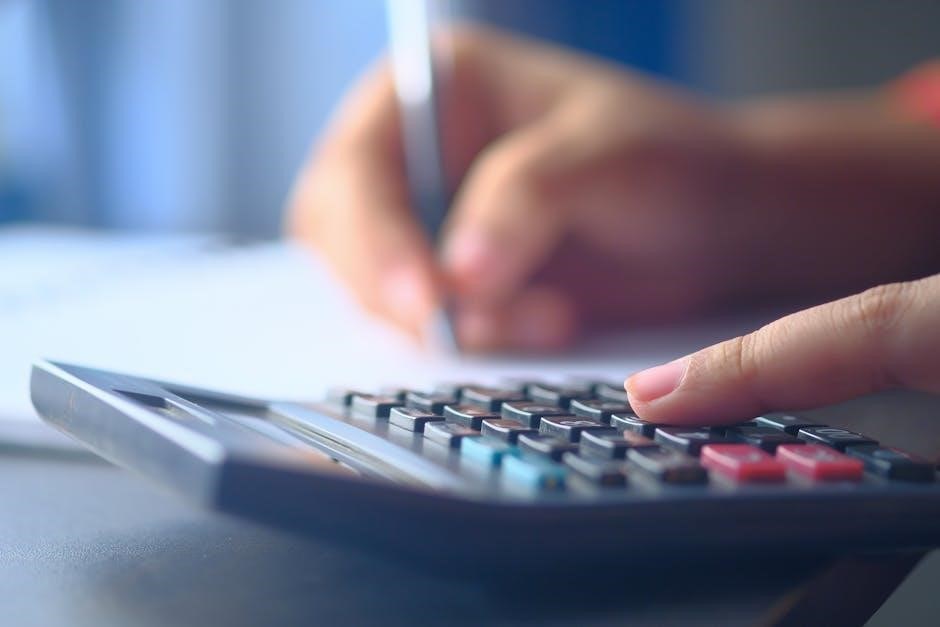
Maintenance and Troubleshooting
Manual calculators require regular cleaning and lubrication to ensure smooth operation. Address jammed parts promptly and align components carefully to prevent damage. Proper servicing extends longevity and functionality.
9.1 Cleaning and Servicing Manual Calculators
Cleaning manual calculators involves using soft brushes or compressed air to remove dust and debris. Apply minimal oil to moving parts to maintain smooth operation. Regular servicing ensures longevity and accuracy, preventing mechanical issues. Avoid harsh chemicals or excessive force to protect delicate components. Proper maintenance enhances performance and reduces wear and tear, keeping your manual calculator reliable for years;
9.2 Common Issues and Solutions
Common issues with manual calculators include jammed mechanisms, misaligned gears, and rusty parts. To resolve these, gently disassemble the device, clean with a soft brush, and apply lubricant. For rusty components, use a mild rust remover. Ensure all parts are reassembled correctly to avoid further malfunctions. Regular maintenance and careful handling can prevent these issues, ensuring smooth operation and extending the calculator’s lifespan. Always refer to the user manual for specific guidance.
9.3 Extending the Lifespan of Manual Calculators
To extend the lifespan of manual calculators, regular maintenance is essential. Clean the device with a soft cloth and avoid exposure to moisture or extreme temperatures. Lubricate moving parts periodically to ensure smooth operation. Store the calculator in a protective case when not in use. Avoid applying excessive force, which can damage internal mechanisms. By following these care tips, manual calculators can remain functional and reliable for years, providing consistent performance and durability.

The Future of Manual Calculators
Manual calculators may evolve with sustainable materials and innovative designs, blending tradition with modern tech, ensuring their relevance in a digital world while promoting eco-friendly solutions.
10.1 Evolution and Innovation
Manual calculators are evolving with innovative designs and sustainable materials, integrating AI for enhanced functionality. They combine traditional mechanics with modern technology, appealing to eco-conscious users. This fusion ensures their relevance in a digital world while promoting eco-friendly alternatives. By blending tactile precision with AI-driven insights, manual calculators offer a unique solution for education and professional settings, emphasizing sustainability without compromising on performance or accuracy.
10.2 Integration with Modern Technology
Manual calculators are increasingly being paired with modern technology, such as AI and digital displays, to enhance functionality. This integration allows users to benefit from tactile operations while accessing real-time computational insights. Such hybrid models cater to educational and professional needs, offering a bridge between traditional methods and digital advancements. This synergy ensures manual calculators remain relevant in a tech-driven world, providing a sustainable and versatile tool for diverse applications.
10;3 Sustainability and Environmental Impact
Manual calculators offer eco-friendly benefits by reducing reliance on battery-powered electronics and minimizing electronic waste. Their long lifespan decreases the need for frequent replacements, conserving resources. By promoting mechanical, energy-free operations, these tools align with sustainable practices, lowering environmental impact. This approach supports a greener future by encouraging responsible consumption and reducing the carbon footprint associated with device production and disposal, making manual calculators a viable, earth-conscious choice in a world prioritizing sustainability.
Manual calculators remain timeless tools, enhancing mental arithmetic skills, ensuring reliability without technology, and offering practical, hands-on solutions in education and professional settings daily.
11.1 Summary of Key Points
Manual calculators are timeless tools offering reliability and precision, ideal for education and professional use. They enhance mental arithmetic skills, providing a practical, hands-on approach to problem-solving. Their durability and low maintenance make them sustainable choices. While modern technology advances, manual calculators remain relevant, complementing digital tools with their unique benefits. They are indispensable for those valuing traditional methods and seeking reliable, eco-friendly solutions.
11.2 Final Thoughts on Manual Calculators
Manual calculators embody a timeless blend of simplicity and functionality, offering a tactile connection to mathematics. They foster mental math skills and serve as dependable tools in environments where electronic devices may fail. While technology advances, these calculators remain cherished for their educational value and durability; For those who appreciate traditional methods, manual calculators provide a satisfying, hands-on experience that complements digital solutions. Their enduring appeal lies in their ability to connect us to the fundamentals of arithmetic, ensuring they remain relevant in a rapidly changing world.
11.3 Encouragement for Further Exploration
Exploring manual calculators offers a rewarding journey into the heart of mathematics and problem-solving. By mastering these tools, users can enhance their mental math skills and gain a deeper appreciation for arithmetic. Whether for education, profession, or personal growth, manual calculators provide a unique, hands-on experience. Their timeless appeal invites curiosity and experimentation, encouraging users to delve into their mechanics, history, and applications. Embrace this opportunity to reconnect with the fundamentals of calculation and discover the joy of working with these enduring devices.
